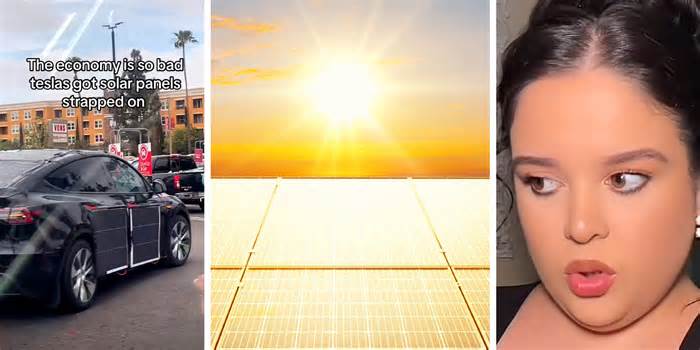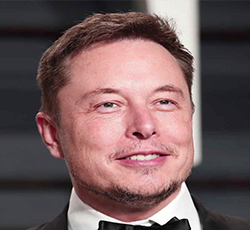
“Charging for free”: Driver spots a Tesla that’s covered in solar panels. Does it work?
- by The Daily Dot
- May 18, 2025
- 0 Comments
- 0 Likes Flag 0 Of 5

Could solar panels outfitting your electric vehicle make it self-reliant? Well, one driver tried it out.
Featured Video
A woman named Sandra (@sandraaaa096 on TikTok) saw a Tesla out on the road with solar panels strapped to it. The strips of sun-absorbent material were outfitted to all four of the vehicle’s doors. Furthermore, the entirety of its panoramic glass roof, along with its trunk, was also covered in panels.
She recorded footage of the EV driving around with the unusual sighting and uploaded it to her TikTok account. The video accrued over 580,000 views, along with hundreds of comments. Many penned that they were equally mortified by the sight. However, some pondered the efficacy of such a rig on the electric vehicle.
Kara quips in a text overlay of the video, “The economy is so bad Teslas got solar panels strapped on.”
Advertisement
One user on the application thought it was a brilliant idea. They said that Tesla should equip every car in its lineup with solar tech. “Honestly how all Tesla should’ve been built. Solar panels in roof. Would never have to charge it again. Smart man,” the commenter wrote.
Someone else agreed. They speculated that leaving the car parked outdoors with this solar arrangement would contribute significantly to their car’s battery.
Another user on the application pointed out that Tesla already offers solar panel products. So why not outfit a car with similar technology? “Tesla makes solar systems roofs/walls so why don’t they build them into the bodies of their vehicles?” they suggested.
Can you solar-charge a Tesla?
Using just the power of the sun to charge an electric vehicle could take a lot of time. This is not only due to the sheer amount of energy it takes to power the lithium-ion batteries in these cars. Additionally, charging speed is another concern. Currently, there are three primary charging velocities that EVs utilize.
Advertisement
Level 1 charging typically refers to standard, 12-volt plug outputs. Typically, these are fine for powering a mobile device such as a phone or tablet. Furthermore, other consumer electronics such as computers, TV sets, sound systems, kitchen appliances, lights, etc., use these outlets.
When it comes to size, it’s helpful to understand nomenclature regarding battery technology. Specifically, amp hours. For instance, take smartphone batteries. The iPhone 16 Pro Max is packing a 4,685 milliamph-hour unit. Conversely, a 2018 Tesla Model 3 has a 150 amp-hour capacity, or 150,000 amp hours. Which means it will take around 32 times the amount of time to fully charge a Tesla Model 3 from zero than this particular iPhone model.
So with a level 1 charger, it’ll take a Tesla owner several days to fully charge their battery. As per this Tesla Motors Club forum post, standard charging only adds around 2-3 miles per hour of charging. If you primarily use an EV to commute to and from work, leaving it plugged in on a standard charger can help. And if you have access to an outlet at work, it could be helpful, depending on your driving habits.
Faster than solar
But for drivers who use their car for more than short-distance driving, higher levels of charging are necessary. But this greater power distribution and threshold come with some stipulations. A traditional three-pronged 12-volt outlet isn’t going to cut it. Level 2 chargers require NEMA 14-50 outlets, the same type you’d find necessary to power some washers and dryers.
Advertisement
These level 2 chargers are capable of fully charging a Tesla, depending on its battery capacity, between 9-12 hours. Outfitting one’s home with a level 2 charger necessitates a NEMA 14-50 outlet. If you don’t have access to at-home charging, then EV fill-ups can be costly.
Different businesses and charging companies set pricing for their plugs at varying rates. This can, in some instances, amount to more than it would cost to fill up a car with gasoline. Again, this is all contingent on the fuel efficiency of a vehicle and what the EV charging rates are.
Tesla charging
If you have an energy provider with reasonable rates, you’ll probably want at-home level 2 charging. There are also vehicles capable of level-3 fast charging. Teslas, for instance, have a wide supercharger network. The Motley Fool writes that as of 2025, there are over 29,000 Tesla supercharger posts available in the United States.
Advertisement
This gives Tesla the largest level 3 charging network in the world. The auto manufacturer has also opened up its superchargers to be used by other EV brands for fast charging capabilities. Oftentimes, these require ports. However, Tesla’s plug, also known as the North American Charging Standard (NACS), is also being adopted by other car makers.
Like Mazda, which has barely dipped its toes into the EV game, announced that future vehicles would be outfitted with NACS plugs.
Solar panel speed
Please first to comment
Related Post
Elon Musk departs from DOGE
- May 31, 2025
Stay Connected
Tweets by elonmuskTo get the latest tweets please make sure you are logged in on X on this browser.






 Energy
Energy


















